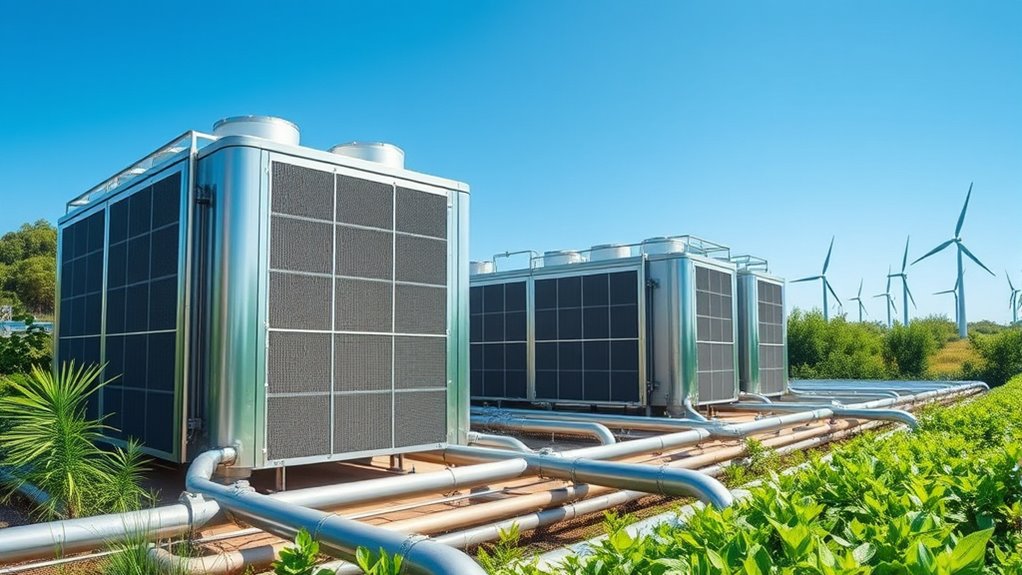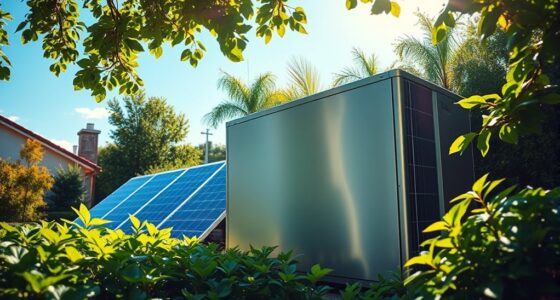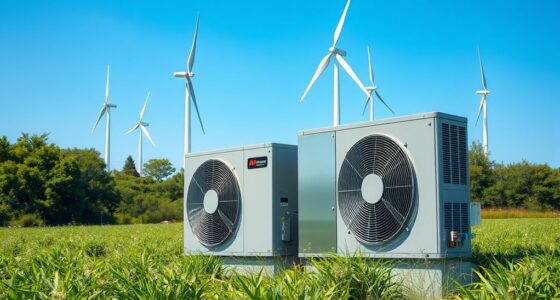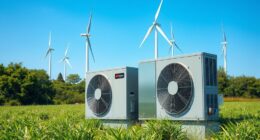Heat pumps are key to making district heating systems more renewable and efficient. They harness low-temperature sources like air, groundwater, or waste heat, converting them into usable heat for urban areas. With advanced technology and smart control, they flexibly match supply with demand, reducing reliance on fossil fuels. By integrating refrigerant innovations and supportive policies, heat pumps help cities cut emissions and optimize energy use. Explore further to see how these systems are shaping sustainable urban energy solutions.
Key Takeaways
- Heat pumps enable flexible, efficient conversion of low-temperature renewable sources like air, groundwater, and waste heat into usable district heating.
- Integration with thermal storage and smart controls optimizes renewable energy utilization and balances intermittent supply and demand.
- Variable-speed compressors and eco-friendly refrigerants improve heat pump efficiency, reducing environmental impact in renewable-powered district heating systems.
- Large-scale heat pump deployment, supported by policies and site selection tools, enhances renewable integration and system scalability.
- AI-driven analytics and centralized dashboards improve system performance, ensuring reliable, sustainable district heating powered by renewables.
How Heat Pumps Enhance Renewable Energy Integration in District Heating
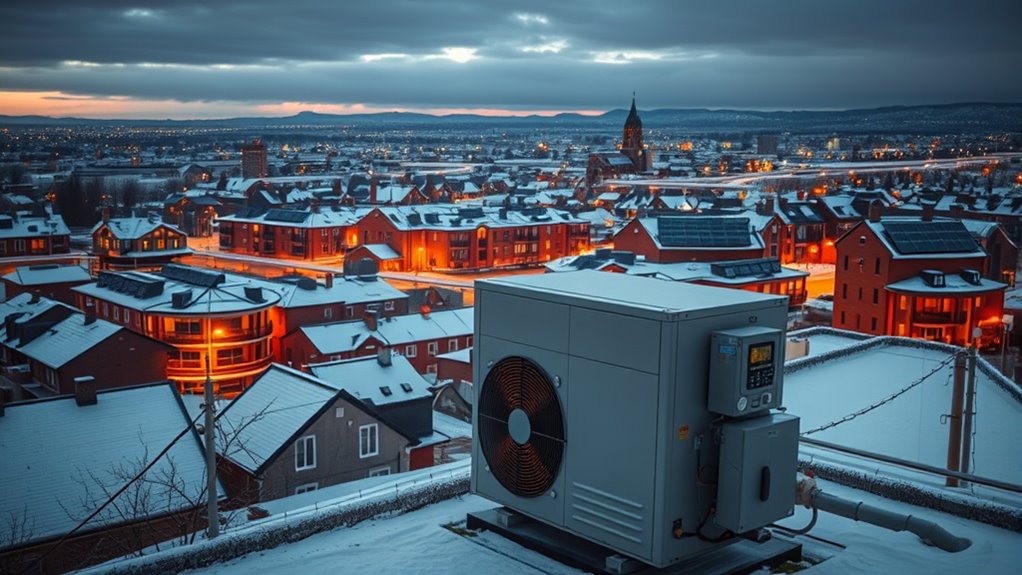
Heat pumps substantially improve renewable energy integration in district heating by flexibly matching energy supply with demand. They efficiently convert low-temperature sources like ambient air, groundwater, or waste heat into usable heat, increasing system efficiency and enabling higher renewable penetration. When combined with thermal storage, heat pumps help balance intermittent renewable supply—such as wind and solar—by storing excess energy for later use. This integration reduces reliance on fossil fuel backup systems and minimizes greenhouse gas emissions. Smart operation of heat pumps allows your district heating network to adapt dynamically to fluctuations in renewable energy availability, optimizing system performance. Additionally, advances in heat pump technology enable even greater efficiency and flexibility in renewable integration. Incorporating smart grid strategies further enhances the responsiveness and reliability of the system. Moreover, implementing demand response measures can optimize energy consumption patterns, improving overall system resilience. Incorporating energy storage solutions can further stabilize supply and demand fluctuations, creating a more balanced system. For example, thermal storage technologies can store excess heat when renewable generation is high, releasing it during periods of low renewable output. Overall, heat pumps strengthen system integration, boost energy efficiency, and create a more sustainable, resilient district heating system powered by renewable energy sources.
Technological Innovations Driving Heat Pump Efficiency and Performance
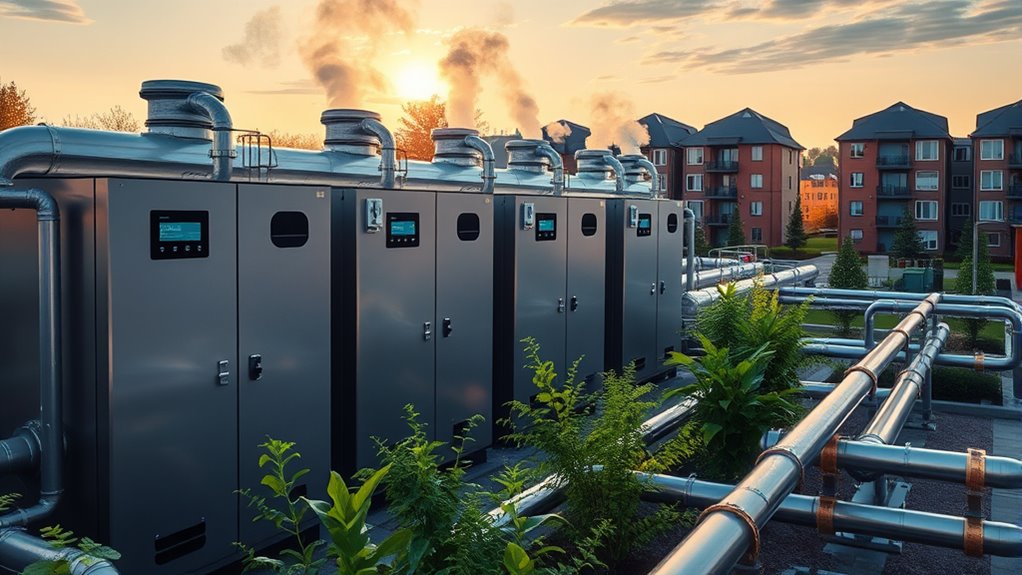
Advances like variable-speed compressors allow your heat pumps to adjust capacity precisely, boosting efficiency and reducing energy use. The adoption of eco-friendly refrigerants, such as propane and isobutane, enhances environmental performance without sacrificing performance. These innovations, combined with smart controls, help optimize operation and maximize the benefits of district heating systems. Incorporating ethical hacking principles can also improve system security by identifying vulnerabilities and safeguarding control systems against cyber threats. Additionally, implementing lifestyle improvements, such as regular maintenance and system monitoring, can further enhance overall performance and longevity. Regular system checks ensure that components operate within optimal parameters, improving system reliability and lifespan. Moreover, understanding regulatory requirements can ensure compliance and facilitate integration with renewable energy sources. Proper tax planning strategies are also vital to maximize financial benefits and sustainability of these systems.
Variable-Speed Compressor Advances
Variable-speed compressors have revolutionized heat pump performance by adjusting their rotational speed in real-time to match heating demands. This precise modulation boosts energy efficiency, especially within district heating systems utilizing renewable energy sources like solar and wind. Recent innovations have increased the responsiveness of these compressors, enabling better integration with fluctuating renewable inputs and demand-side management. They also improve system stability and extend equipment lifespan by maintaining consistent operation. Advanced control algorithms allow for predictive control, optimizing energy use and enhancing resilience across district heating networks.
- Improve load matching for fluctuating renewable energy inputs
- Enhance system stability and longevity
- Enable smarter demand-side management through predictive control
Eco-Friendly Refrigerants Utilization
Have you considered how the shift to eco-friendly refrigerants is transforming heat pump technology? Using low-GWP refrigerants like propane (R290) and isobutane (R600a) dramatically reduces the environmental impact of district heating systems. These natural refrigerants, with GWPs below 10, help lower the carbon footprint compared to traditional HFCs with GWPs over 1,000. Technological innovations, such as advanced heat exchangers and variable-speed compressors, enhance heat pump efficiency when employing eco-friendly refrigerants. Developing low-GWP refrigerants compatible with high-temperature applications enables better integration with renewable energy sources. This not only improves overall performance but also supports sustainable district heating networks, making the systems more environmentally benign. Recognizing the importance of allergy risks from super seeds can also inform sustainable practices and safety considerations in related fields. Ultimately, utilizing eco-friendly refrigerants advances the goal of cleaner, more efficient district heating powered by renewable energy.
Successful Urban Examples of Heat Pump-Driven District Heating Systems
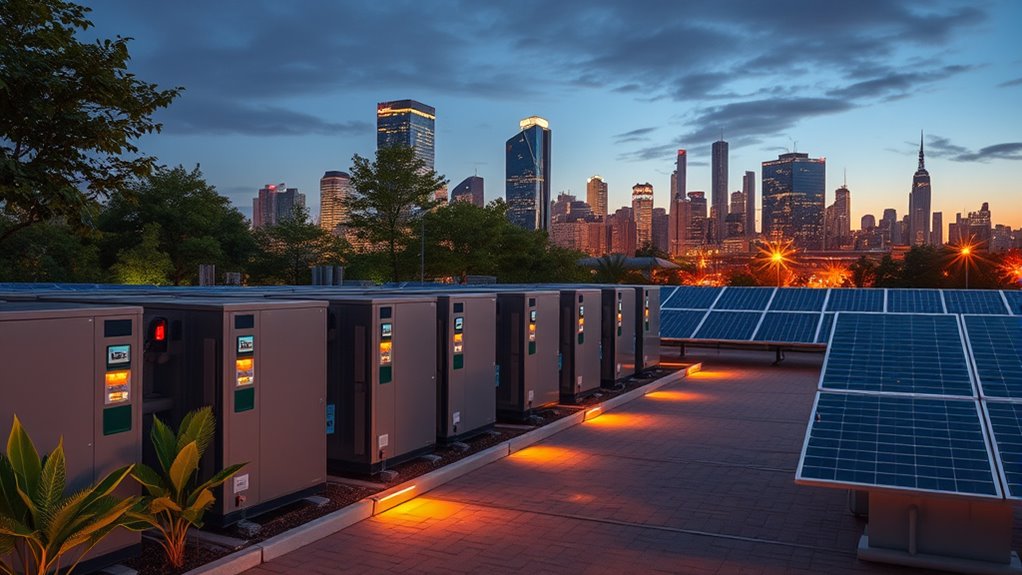
Cities like Copenhagen and Amsterdam showcase how heat pumps can transform district heating systems. Copenhagen’s geothermal projects aim for carbon neutrality, while Amsterdam reuses waste heat from industry and data centers. These examples prove that integrating heat pumps with renewable or waste sources boosts sustainability and efficiency. Moreover, the successful implementation of such systems relies on local legal frameworks that support innovative energy solutions. Establishing standardized installation practices is also crucial to ensure system reliability and scalability across different urban environments. Additionally, leveraging AI-driven analytics can optimize system performance and facilitate maintenance planning, further enhancing system resilience. Incorporating vibrational energy principles from the Law of Attraction can inspire innovative approaches to system design and community engagement, emphasizing the importance of technological innovation in advancing sustainable urban energy infrastructure.
Copenhagen’s Geothermal Initiative
Copenhagen’s geothermal initiative exemplifies how large-scale heat pumps can transform urban district heating. By using geothermal heat pumps, the city harnesses sustainable heat from deep boreholes, seamlessly integrating it into its district heating system. This project supports Copenhagen’s goal to become carbon-neutral by 2025, profoundly reducing greenhouse gas emissions. The initiative demonstrates that renewable energy sources like geothermal heat can reliably supply sustainable heat on a large scale, replacing fossil fuels. As a result, Copenhagen moves closer to its climate targets and sets a model for other cities seeking low-emission heating solutions.
- It highlights the potential of geothermal heat pumps to provide reliable, renewable heat.
- It showcases how urban districts can considerably cut their carbon footprint.
- It emphasizes the importance of integrating sustainable heat sources into existing infrastructure.
Amsterdam’s Waste Heat Recovery
Amsterdam exemplifies how integrating waste heat from data centers and industrial processes with advanced heat pump technology can create an efficient, low-carbon district heating system. By capturing waste heat that would otherwise be discarded, the city enhances energy recovery and reduces reliance on fossil fuels. Heat pumps upgrade this surplus heat, transforming it into sustainable urban heating for thousands of households and businesses. This approach demonstrates a smart way to leverage renewable sources and surplus industrial heat, maximizing resource reuse. The project highlights how waste heat recovery combined with heat pump technology can deliver scalable, environmentally friendly district heating solutions. Amsterdam’s example underscores the potential for urban centers to adopt circular, sustainable heating systems that minimize environmental impact and support climate goals.
Environmental and Economic Benefits of Switching to Heat Pump-Powered District Heating
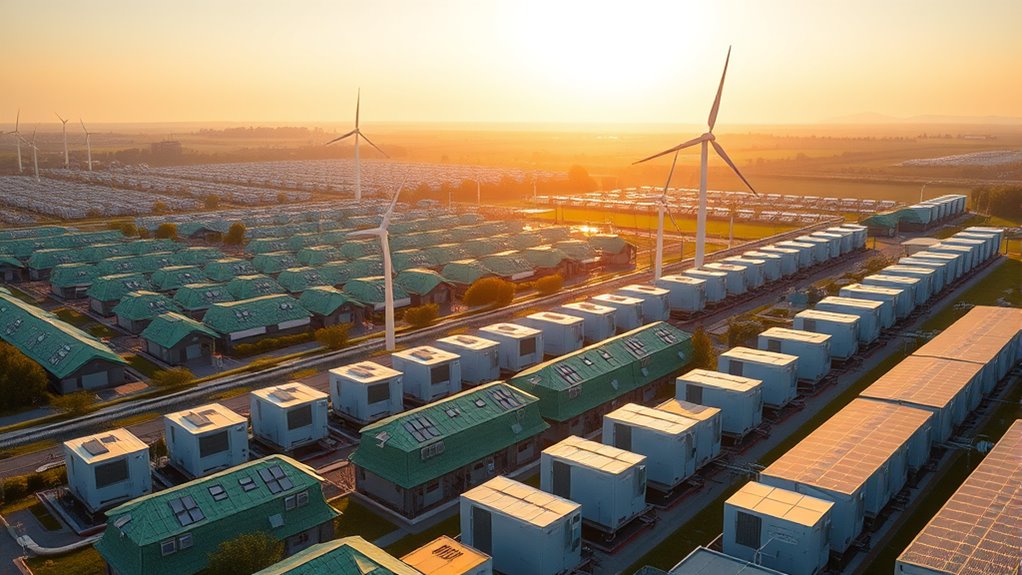
Switching to heat pump-powered district heating offers substantial environmental and economic advantages. By adopting heat pumps, you can reduce greenhouse gas emissions from urban areas by over 70%, helping meet climate targets. Integrating these systems with renewable energy sources like wind and solar boosts energy efficiency and lowers overall costs. This shift also allows you to harness low-temperature waste heat and surplus renewable energy, maximizing resource use and decreasing reliance on fossil fuels. Cities like Copenhagen and Amsterdam show that deploying heat pumps in district heating networks results in lower operating costs and greater energy resilience. Moreover, the use of best hot rollers for long hair can facilitate quick styling for professionals working in energy-efficient environments, showcasing the versatility of modern tools. Implementing advanced payment security measures is crucial for protecting the financial transactions involved in energy infrastructure projects.
- Reducing greenhouse gas emissions promotes cleaner air and a healthier environment
- Enhancing energy efficiency cuts long-term costs and boosts system sustainability
- Supporting renewable energy integration fosters economic growth and job creation
Multi-Criteria Decision-Making Tools for Optimal Heat Pump Placement and System Design
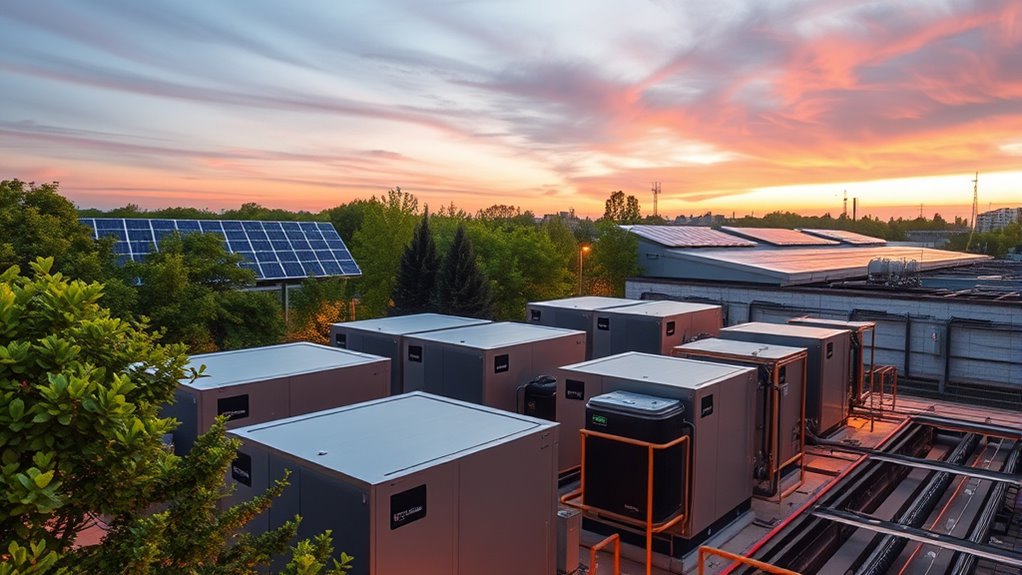
To maximize heat pump deployment within district heating systems, decision-makers increasingly rely on multi-criteria decision-making (MCDM) tools that analyze spatial, technical, economic, and environmental data. These tools facilitate effective site selection and heat pump placement by integrating diverse criteria like wind speed, solar irradiation, and proximity to heat sources. GIS-based models using Boolean and fuzzy logic help identify ideal locations, while frameworks such as the Analytic Hierarchy Process (AHP) prioritize key factors to refine system design. Hybrid modeling tools like EnergyPLAN and HOMER simulate performance and aid in optimization, ensuring efficient renewable integration. Capacity calculations from these assessments guide infrastructure development, enabling cost-effective operation and seamless integration of heat pumps into renewable-powered district heating networks. Considering environmental impact assessments ensures that the selected sites support sustainable and eco-friendly district heating solutions. Additionally, incorporating security measures into system design can protect against cyber threats, ensuring the resilience and integrity of the entire district heating infrastructure.
Designing Hybrid Renewable Systems Combining Solar, Wind, and Heat Pumps
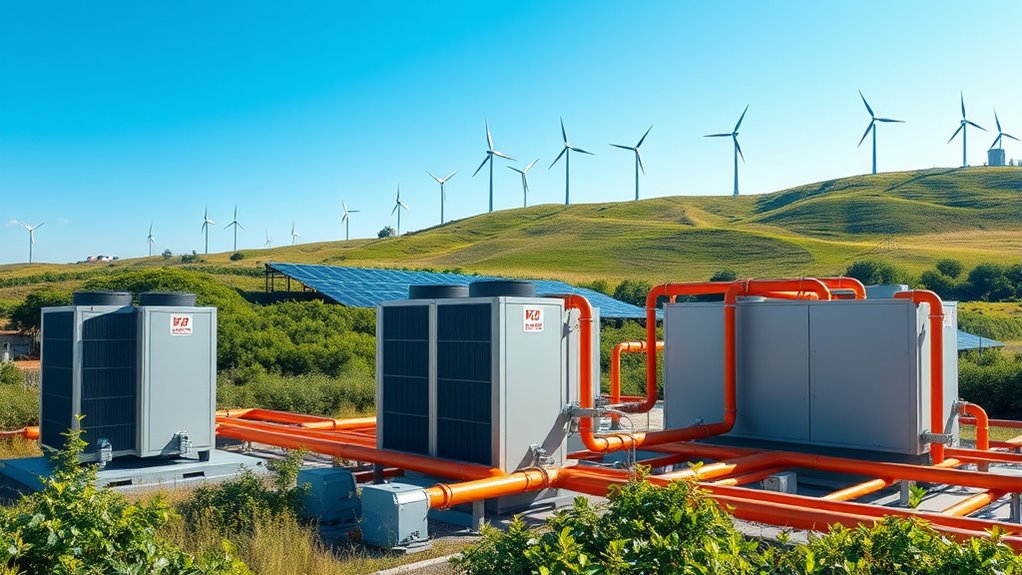
Designing hybrid renewable systems that combine solar, wind, and heat pumps offers a promising pathway to maximize renewable energy integration in district heating networks. These systems can reach renewable penetration rates of up to 78% and deliver energy at costs as low as $0.0422 per kWh. Using GIS-based site assessments helps identify ideal locations for solar PV, wind turbines, and heat pump infrastructure, considering resource availability and proximity to heat demand centers. Combining solar thermal/photovoltaic, wind, and waste incineration enables efficient utilization of variable renewable sources, balancing supply and demand. Optimization techniques like particle swarm optimization (PSO) enhance system performance by minimizing costs. With tools like HOMER, you can compare configurations to ensure reliable, cost-effective, and sustainable district heating solutions. Hydrogen’s role as a renewable energy carrier can further support decarbonization efforts within these systems, especially when produced from renewable sources like electrolysis powered by wind and solar. Incorporating energy storage solutions, such as thermal energy storage, can improve system flexibility and resilience in the face of intermittent renewable energy supply. Additionally, integrating energy storage technologies can help smooth out supply fluctuations and improve overall system efficiency. Understanding the regulatory frameworks is essential to facilitate the deployment of these advanced hybrid systems effectively. Implementing community engagement strategies can also promote acceptance and support for renewable district heating projects.
Overcoming Challenges in Implementing Heat Pumps for Large-Scale District Heating
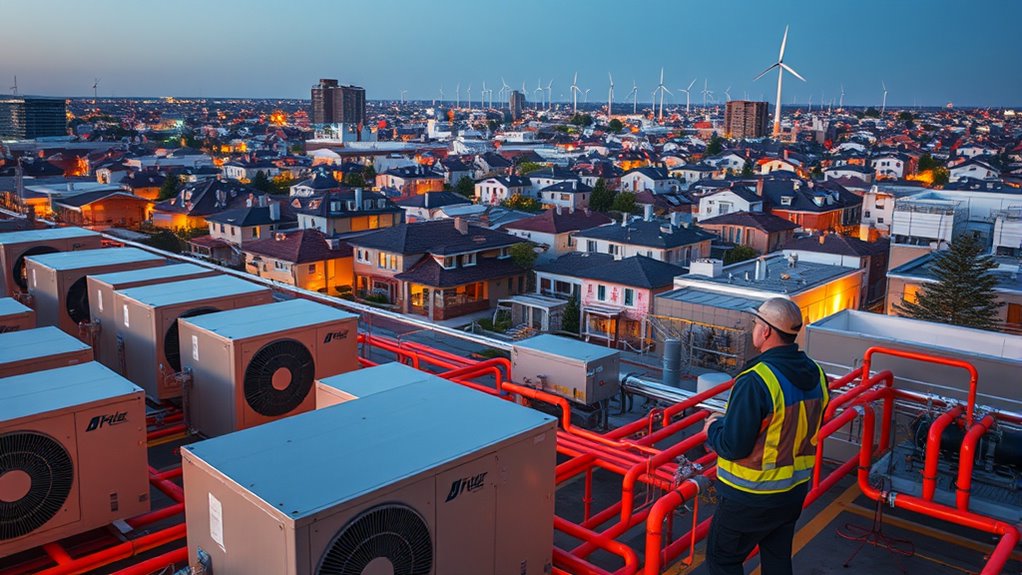
Implementing heat pumps at a large scale in district heating systems presents several technical and economic hurdles. Large-scale heat pumps must maintain high operational efficiency across variable loads, which challenges system integration with existing infrastructure. Securing reliable, low-temperature renewable energy sources is vital but often inconsistent, complicating system control. High capital costs and long payback periods, sometimes over a decade, hinder widespread adoption despite potential operational savings. Managing thermal storage and balancing intermittent renewable inputs adds complexity to system stability. Additionally, regulatory barriers and the lack of supportive policies can delay large-scale deployment. Overcoming these challenges requires innovations in system control, strategic infrastructure upgrades, and policy frameworks that incentivize the integration of large-scale heat pumps into renewable-powered district heating networks. Recognizing the importance of policy support is essential for accelerating adoption and overcoming regulatory hurdles.
The Future of Smart Control and Monitoring in Renewable District Heating Networks

The future of renewable district heating networks is being reshaped by smart control and monitoring technologies that enable real-time management of heat pumps. You’ll benefit from advanced systems that use IoT devices and smart sensors to gather detailed data on temperature, flow, and energy use. Predictive analytics allow for proactive maintenance and demand forecasting, reducing costs and preventing downtime. Adaptive control algorithms automatically adjust heat pump operation based on renewable energy availability, weather, and grid demand, increasing system flexibility. Digital platforms provide centralized dashboards, boosting transparency and empowering you to make informed decisions. Maximize Space and Organization by integrating these technologies into your system for optimal efficiency and management. Additionally, the integration of smart utilities helps optimize energy consumption and enhances overall system performance.
Policy and Regulatory Frameworks Supporting Heat Pump Adoption in Cities

Policy and regulatory frameworks play a pivotal role in accelerating heat pump adoption within urban district heating systems. Governments support this shift through policies that offer incentives, subsidies, and tax benefits, making renewable heating solutions more attractive. Regulations such as renewable energy mandates and efficiency standards create clear targets, driving cities to integrate heat pumps into their infrastructure. Supportive national and regional policies often promote expanding district heating networks and incorporating renewable sources, easing the installation process. Countries like Denmark, Sweden, and the UK have established strategic frameworks and funding programs to boost urban heat pump adoption. Additionally, measures like carbon pricing and phasing out fossil fuel subsidies create economic support, incentivizing cities to transition toward cleaner, heat pump-powered district heating systems aligned with renewable energy goals.
Strategies for Scaling Up Heat Pump Use in Urban and Industrial District Heating Systems
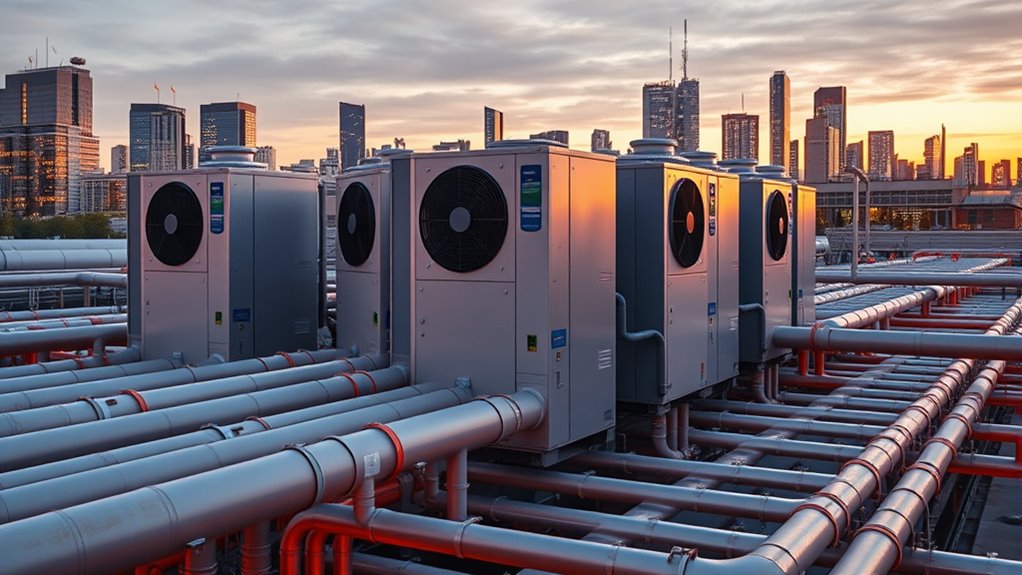
Scaling up heat pump use in urban and industrial district heating systems requires deploying large-capacity, high-efficiency heat pumps capable of meeting substantial energy demands. To achieve this, you should focus on heat pump integration within scalable district heating networks, ensuring systems can expand as needed. Combining heat pumps with renewable energy sources like solar thermal and wind creates hybrid energy systems that reduce fossil fuel reliance and improve sustainability. Conducting GIS assessments helps identify *conducive* locations for installing high-capacity heat pumps and infrastructure, maximizing efficiency. Policy incentives play a *crucial* role, encouraging investments and technological advancements.
- Optimize site selection through GIS assessment
- Develop hybrid energy systems to enhance scalability
- Leverage policy incentives to accelerate adoption
Frequently Asked Questions
Do Heat Pumps Use Renewable Energy?
You might wonder if heat pumps use renewable energy. The answer is yes, they can, especially when powered by electricity from renewable sources like wind or solar. They extract heat from renewable sources such as ambient air or the ground, making their operation sustainable. However, if the electricity comes from fossil fuels, their renewable benefits decrease. So, their renewable nature depends on the energy mix behind their electricity supply.
What Is the Difference Between Heat Pump and District Heating?
Did you know that heat pumps can be up to three times more efficient than traditional boilers? The key difference is that heat pumps transfer heat from sources like air or ground, using electricity, while district heating distributes hot water or steam from a centralized plant. You operate heat pumps individually or in networks, whereas district heating supplies multiple buildings from a single, large-scale source.
What Is the Advantage of Using a Heat Pump in a Sustainable Domestic Heating System?
Using a heat pump in your sustainable domestic heating system offers several advantages. It extracts low-temperature heat from the environment, making it highly efficient and reducing your energy bills. It also enables you to use renewable energy sources like air, ground, or wastewater, cutting greenhouse gas emissions. Plus, it provides flexible operation aligned with renewable availability, helping you contribute to a cleaner, more sustainable future while maintaining comfort in your home.
What Is the Purpose of a Heat Pump System?
You might be surprised to learn that heat pumps can deliver 3 to 4 times more thermal energy than the electrical energy they consume. Their purpose is to transfer heat from a low-temperature source, like air or ground, to a higher temperature for heating. fundamentally, they provide an efficient, sustainable way to heat large areas, reducing reliance on fossil fuels and supporting renewable energy use.
Conclusion
By embracing heat pumps in district heating, you can seamlessly boost renewable energy use, cut emissions, and save costs. With technological advances and supportive policies, scaling these systems becomes more feasible than ever. Imagine a city where every building’s warmth is powered cleanly—how much cleaner and greener could your community become? The future of sustainable urban heating is within your reach—are you ready to take the next step toward smarter, greener cities?
